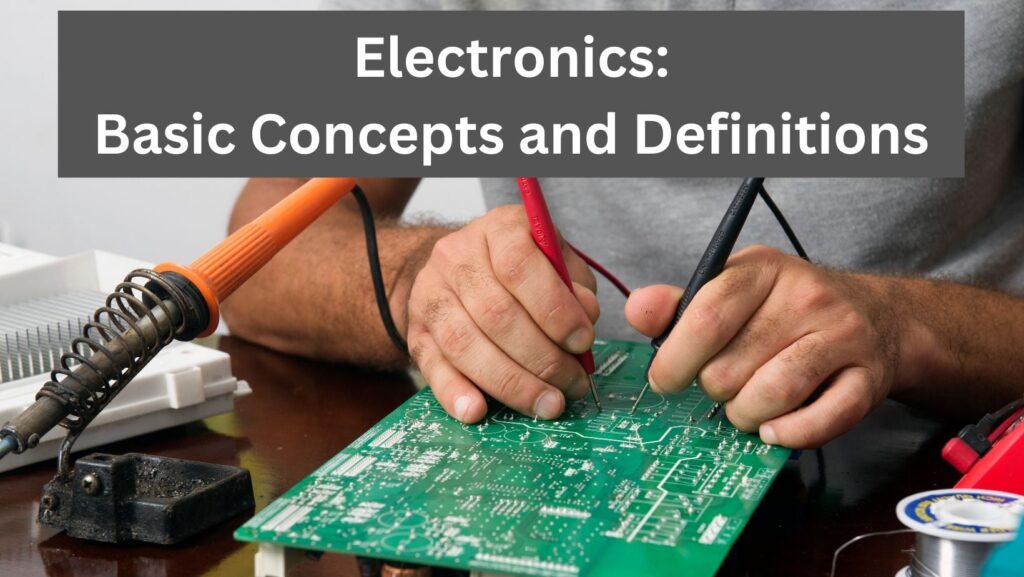Understanding Basic Concepts and Definitions of Electronics
Introduction
Electrical and electronics engineering is a fascinating field that powers the technology-driven world we live in. In this introductory chapter, we will explore some fundamental concepts that serve as the building blocks for understanding and working with electricity and electronics.
Understanding these foundational ideas is essential, as they are the keys to unlocking the mysteries of circuits, devices, and systems that surround us. Whether you’re an aspiring engineer, a hobbyist, or simply curious about how the world of electronics functions, this knowledge is invaluable.
Basic Concepts and Definitions

We’ll delve into voltage, current, resistance, power, and capacitance, providing you with the technical definitions necessary to comprehend more advanced concepts in the field. So, let’s embark on this enlightening journey into the world of electrical and electronics.
Voltage (V): The Electric Potential Difference
Voltage, represented by the symbol V, is the electric potential difference between two points in a circuit. It’s measured in volts (V). Voltage is what drives the flow of electric charge, much like the force that makes water flow in a pipe. The higher the voltage, the greater the electric “push” that causes electrons to move.
Current (I): The Flow of Electrons
Current, denoted as I, represents the flow of electric charge in a circuit. It’s measured in amperes (A). Current is the rate at which electric charge (electrons) moves through a conductor. It’s analogous to the rate of water flow in a river.
Resistance (R): Opposition to Current Flow
Resistance, symbolized as R, is the property of a material that opposes the flow of electric current. It’s measured in ohms (Ω). Materials with high resistance impede current flow, while those with low resistance allow electrons to move more easily. Resistance is crucial in determining how much current flows through a circuit for a given voltage.
Power (P): Rate of Energy Transfer
Power, represented as P, is the rate at which energy is transferred or converted in an electrical circuit. It’s measured in watts (W). In electrical terms, power is the product of voltage and current (P = V × I). It tells us how quickly work is done or how much energy is consumed by an electrical device.
Capacitance (C): Ability to Store Electric Charge
Capacitance, denoted as C, is a property of capacitors and represents their ability to store electric charge. It’s measured in farads (F). Capacitors store energy in the form of an electric field, and they can release this stored energy when needed. Capacitors are often used in various electronic applications to control the flow of electric charge.
These technical definitions provide a more precise understanding of these fundamental electrical and electronics concepts. They form the basis for analyzing and designing electrical circuits and systems
FAQs
What are the basic concepts of electricity?
Voltage, current, resistance, and power are the fundamental concepts of electricity.
What are the 4 types of electricity?
Static electricity, current electricity, conduction electricity, and induction electricity.
What is meant by 1 ampere?
One ampere (1 A) represents a flow of one coulomb of electric charge per second through a conductor.
What is the SI unit for voltage?
The SI unit for voltage is the volt (V).
What is unit voltage?
Unit voltage usually refers to one volt (1 V) in electrical terms.
What is the SI unit of current?
The SI unit of current is the ampere (A).
What is the resistor unit?
The unit of resistance is the ohm (Ω).
What is SI unit of resistance?
The SI unit of resistance is also the ohm (Ω).
What is the current formula?
The current formula is I = V/R, where I is current in amperes (A), V is voltage in volts (V), and R is resistance in ohms (Ω).
What is the energy formula?
The energy formula is E = P × t, where E is energy in joules (J), P is power in watts (W), and t is time in seconds (s).
Conclusion
In this chapter, we’ve explored the bedrock of electrical and electronics engineering. These fundamental concepts – voltage, current, resistance, power, and capacitance – are the cornerstones upon which more complex electrical and electronic systems are built.
As you progress in your understanding of this field, these concepts will continue to serve as your guiding lights, helping you decipher circuits, troubleshoot issues, and design innovative solutions. Whether you’re pursuing a career in electrical engineering, tackling DIY projects, or just developing a deeper appreciation for the technology that shapes our world, mastering these basics is an essential step on your journey.
With these foundational concepts in place, you’re now prepared to tackle more advanced topics and explore the intricate world of electrical and electronics engineering. So, stay curious, keep learning, and be prepared to be amazed by the limitless possibilities that this field offers.
 Electrical Engineering World Wiring a Brighter Tomorrow!
Electrical Engineering World Wiring a Brighter Tomorrow!